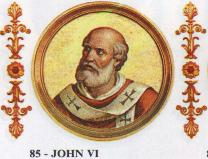
John VI John VI, who was of Greek descent, was elected pope in 701. He put down a rebellion against Theophylactus, the imperial exarch, and ransomed the Campanian prisoners of Duke Gisulfo of Benevento after a war between the two states. When, in 704, Bishop Wilfrid of York appealed to Rome for the third time with the claim that he had been unlawfully deposed from his see, John recommended that he take the matter up with the Archbishop of Canterbury. John died in the following year.
- Pope John VI can also refer to Pope John VI of Alexandria.
Pope John VI (Latin: Ioannes VI; 655 – 11 January 705) was the bishop of Rome from 30 October 701 to his death. John VI was a Greek from Ephesus who reigned during the Byzantine Papacy. His papacy was noted for military and political breakthroughs on the Italian Peninsula. He was succeeded by Pope John VII after a vacancy of less than two months. The body of the pope was buried in Old St. Peter's Basilica.
Greek papacy
A Greek from Ephesus, John VI succeeded Sergius I. His selection occurred after a vacancy of less than seven weeks. John assisted Exarch Theophylactos, who had been sent to Italy by Emperor Tiberius III, and prevented him from using violence against the Romans. John VI's interventions prevented Theophylactos from being injured, having come to Rome to "cause trouble for the pontiff".
In 704, after being expelled, yet again, from his see, the elderly Bishop Wilfrid of York went to Rome and pleaded his case "before the apostolic Pope John [VI]". Wilfrid had visited Rome in 654 and 679 and witnessed the progressive transformation of the Church administration to a Greek-dominated hierarchy. Because of this, John VI convened a synod of Greek-speaking bishops to hear Wilfrid's cause, a linguistic hurdle that much perturbed Wilfrid. Nonetheless, the synod exonerated Wilfrid, restored him to his see, which he occupied until his death in 709, and sent him back with letters for King Æthelred of Mercia for papal mandates to be implemented. John also sent the pallium to Berhtwald, whom Sergius I had confirmed as archbishop of Canterbury.
Relations with Lombards
John succeeded in inducing Duke Gisulf I of Benevento to withdraw from the territories of the empire through tactics of persuasion and bribery. According to some sources, he "single-handedly convinced the Lombard duke Gisulf of Benevento to withdraw his forces and return home" after the duke had devastated the neighboring Campanian countryside and constructed an encampment within sight of the city walls of Rome. Distressed at the sufferings of the people, Pope John sent a number of priests furnished with money into the camp of the Lombard duke to ransom all the captives whom Gisulf had taken.
Other significant events during John VI's pontificate include the Lombard king Aripert II returning the Cottian Alps to their former status as a papal patrimony. Numerous construction projects also occurred, including new ambon in the Basilica of St. Andrew the Apostle, a new altar cloth for San Marco, and "suspended diaphonous white veils between the columns on either side of the altar in San Paolo. John VI also promoted easterners within the episcopal hierarchy, including Boniface, the papal counselor.
Notes
- ^ Ekonomou, 2007, p. 246.
- ^ M. Benedik: Papeži od Petra do Janeza Pavla II., Mohorjeva družba Celje 1989. Page 69.
- ^ Chisholm, Hugh, ed. (1911). . Encyclopædia Britannica. 15 (11th ed.). Cambridge University Press. p. 434.
- ^ Ekonomou, 2007, p. 270.
- ^ Ekonomou, 2007, p. 245.
- ^ Mann, Horace. "Pope John VI." The Catholic Encyclopedia Vol. 8. New York: Robert Appleton Company, 1910. 25 October 2017
- ^ Ekonomou, 2007, p. 248.
![]() This article incorporates text from a publication now in the public domain: Herbermann, Charles, ed. (1913). "Pope John VI". Catholic Encyclopedia. New York: Robert Appleton Company.
This article incorporates text from a publication now in the public domain: Herbermann, Charles, ed. (1913). "Pope John VI". Catholic Encyclopedia. New York: Robert Appleton Company.





